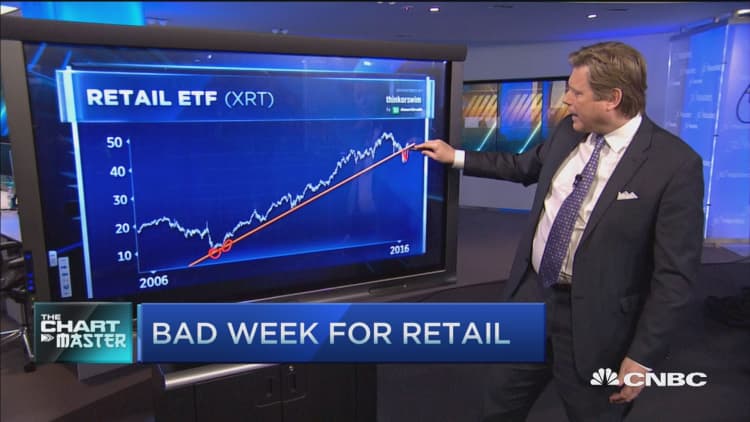Many women are familiar with the feeling. You're scouring the shelves at your favorite store and find the perfect top to match your new skirt. After wrestling with other shoppers and squeezing into the fitting room, you slip on the garment under the bright fluorescent lights. But when you look in the mirror, you discover that seemingly perfect top is completely see-through.
Such an experience is sure to disappoint many consumers — and could cause a retailer to forfeit a sale. Yet as labor costs rise around the globe, many companies are leaning on cheap, lightweight fabrics as a means to cut costs and protect their margins. Not only do thinner synthetic fabrics translate into lower material prices, but their lighter weight (as related to cotton) means they're also less expensive to transport.
But in a world where basic camisoles and tank tops can be on the shelves for $3 or less, are prices finally as low as they can go? According to industry experts, there remains a little wiggle room left for retailers selling apparel at these prices — but not much.
"We probably are close to or at rock bottom," said Vincent Quan, an associate professor at the Fashion Institute of Technology.
Cutting cotton to cut costs
When producing a garment, roughly 50 to 60 percent of the cost comes from the raw materials, according to Brian Ehrig, retail strategist at Kurt Salmon. Another 20 to 30 percent is tied to labor, with the remainder of the expense attributable to transportation, duties and other supply chain costs. That means, when combining the fabric's price with shipping expenses, the majority of a garment's cost is directly related to the material.
Though cotton prices have remained relatively stable over the past few years — and are nearly a quarter what they were at their all-time high in 2011 — the cost of labor is rising in the double digits, Ehrig said. That presents retailers with two popular options to protect their margins. They can either shift production to lower-cost countries in Southeast Asia — despite the potential implications it could have on worker conditions — or use lower-cost materials.
"If the consumer isn't going to pay more for the same product and the input prices are rising, or at least a few are rising double digits, they have to cut somewhere," Ehrig said. "Raw materials, because that's where the cost is, that's one of the levers they have to pull."
The result are what are referred to in the industry as "tissue tees," Quan said. These lower-quality tops can be made from rayon (derived from wood pulp) or other synthetic materials, he said. By using such lighter fabrics, clothing is both cheaper to produce and ship.
"The truth is you can create sheer tees from practically anything," Quan said.
While cutting costs in this manner can lead to substandard goods, the ramifications are significantly less dire than retailers seeking out cheaper — and potentially more dangerous — factories in which to produce their garments.
Following a 2013 factory collapse in Dhaka, Bangladesh, and similarly devastating events, the treatment of workers has become a major focal point among critics of fast-fashion. They have been fighting to raise wages and improve the conditions of the factories in which they work.
"Labor costs are always going up," Quan said.
Choosing door No. 3
There is yet another way retailers can alleviate the pressure on their margins, which many are not yet using, Kurt Salmon's Ehrig said. By purchasing raw materials well in advance — something fast-fashion retailers already do — they can land a better price. They can then pass along those savings to improve a garment's quality. Today, most retailers design their products before they buy the materials.
"The companies have to actually flip the way that they ordinarily operate," Ehrig said.
FIT's Quan said there's still some wiggle room for retailers charging $10 or more for a T-shirt to lower their prices. The real cost to produce a simple tee is somewhere around $2 or $1.50, meaning they could still record a profit if they trimmed the price tag. Once they get down to $5, however, "there's not much breathing room left," Quan said.
"They're not going to give it away for free," he said. However, he did acknowledge that some retailers could use such low-price items as "loss leaders," meaning they don't earn a profit off of them, but use them as a means for generating traffic.
"The additional purchases on top [are] what you're looking for," he said.

The problem lies in when the product becomes so cheaply made that consumers view it as a waste of money. Ehrig said this is something that the retailers he works with are becoming more aware of, adding they're trying to improve the quality of their merchandise while still delivering savings.
It's also worth noting that in some cases, selling sheer "tissue tees" is a conscious decision retailers are making. Sometimes, they're produced with the intention of the shopper layering them on top of a colored blouse or bralette, to create a "sexy" look, Quan said.
"It leaves a lot to the imagination," he said. "That's probably one of the fashion reasons why it's trendy."





